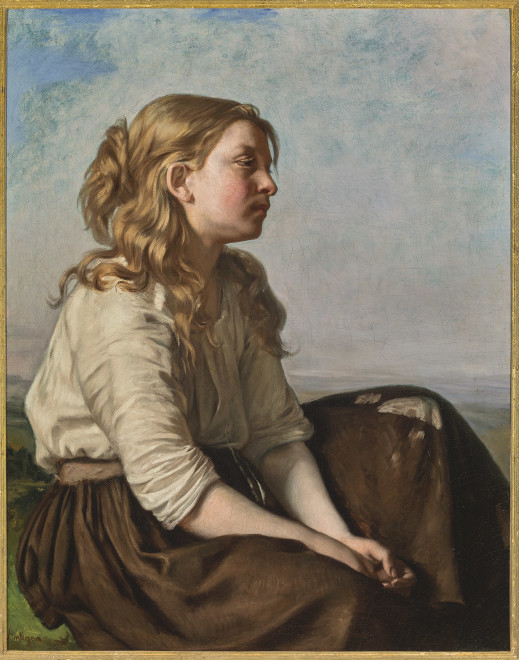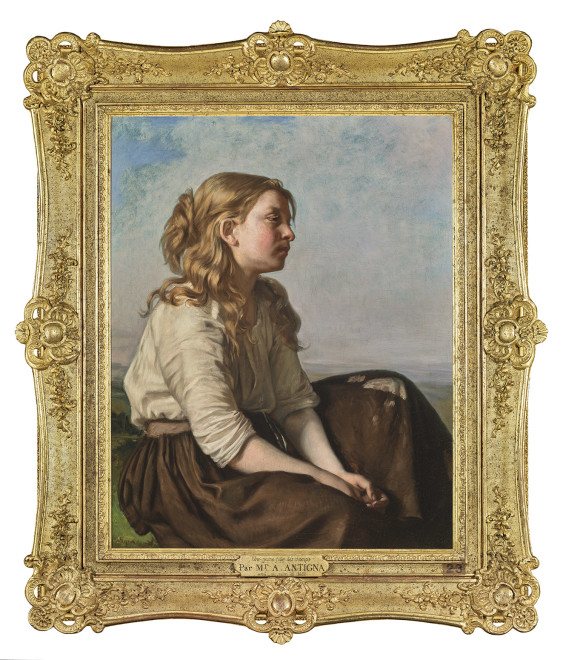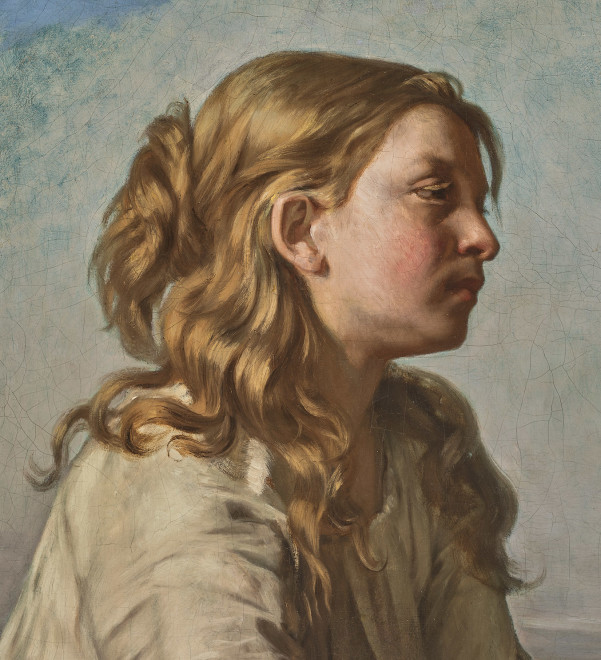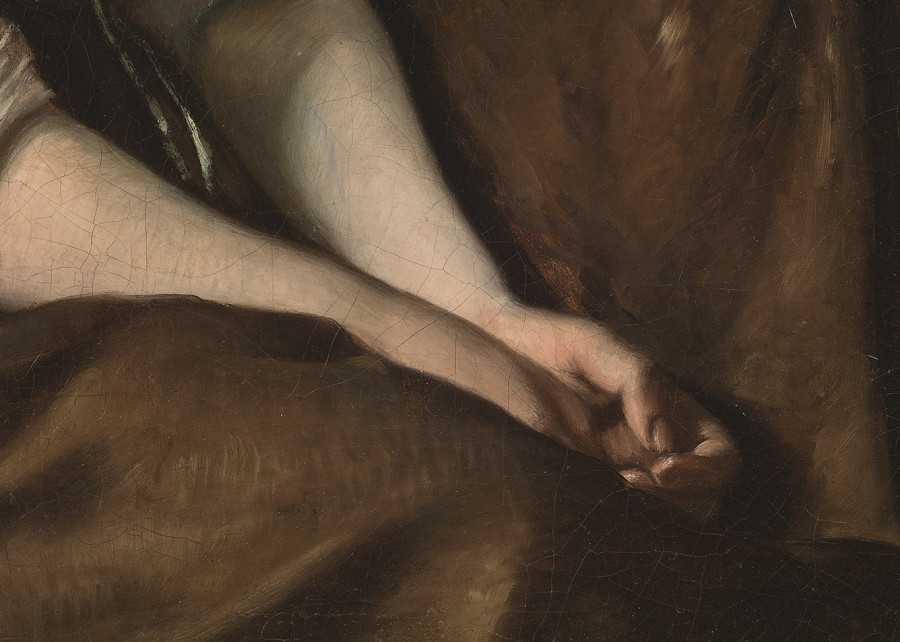Jean-Pierre Alexandre Antigna was a first-generation French Realist painter, who came to prominence in the aftermath of the 1848 Revolution. His early career coincided with that of Gustave Courbet, Jean François Millet and Jules Breton; all four young painters gained recognition (and in the case of Courbet, notoriety) at the Salon of 1850/51, which is heralded as the official beginning of the Realist movement.
Provenance
Artist’s studio sale, Pillet, Paris, 13-14 June 1878, lot 247 as La Blonde
Private collection, France
Exhibited
Paris, Salon des artistes français, 1852, no. 23, as Une jeune fille des champs
Literature
Courtois, "Salon de 1852, Peinture-Sculpture, 4e article," Le Corsaire, 24 avril 1852, np
Théophile Gautier, "Salon de 1852, 4e article," La Presse, 11 mai 1852, p. 1
Émile de Girardin, "Exposition de 1852," La Mode: revue des modes, galerie de mœurs, album des salons, 5 May 1852, p.147
Edmond et Jules de Goncourt, Salon de 1852, Paris, Levy, 1852, p. 5-6
Alphonse Grün, "Salon de 1852," Album de l'École de dessin : journal des jeunes artistes et des amateurs, no. 12, 25 October, p. 2
Alphonse Grün, Salon de 1852, Paris, 1852, p. 62
Nadar, Album du Salon: Nadar jury 1852, Paris, Aux bureaux de l'Eclair, 1852, np
Augustin Joseph du Pays, L’Illustration, journal universel, vol.19, 22 May 1852, p. 346
Louis Peisse, "Salon," Le Constitutionnel, no.119, 28 April 1852, p. 1
Claude Vignon, "Les réalistes et les coloristes," Salon de 1852, Paris, Dentu, 1852, p. 97
Jules Antoine Castagnary, Les artistes au XIXe siècle. Salon de 1861, 1ere série, Paris, Librarie Nouvelle, 1861, p.28
Louis Auvray, Dictionnaire des artistes de l’école française, Paris, Renouard, 1882, p.19
Genevière Lacambre, "Un photographe au Salon de 1852, Hommage à Hubert Landais - Art, objets d'art, collections," Eudes sur l'art du Moyen Age et de la Renaissance, sur l'histoire du goût et des collections, Paris, Blanchard Editeur, 1987, p.198, 203
Jean-Paul Bouillon (ed.), La Promenade du critique influent: anthologie de la critique d’art en France, 1850-1900, Paris, Hazan, 1990, p. 31
Catalogue note
Jean-Pierre Alexandre Antigna was a first-generation French Realist painter, who came to prominence in the aftermath of the 1848 Revolution. His early career coincided with that of Gustave Courbet, Jean François Millet and Jules Breton; all four young painters gained recognition (and in the case of Courbet, notoriety) at the Salon of 1850/51, which is heralded as the official beginning of the Realist movement. Courbet’s entries included The Burial at Ornans (Musée d’Orsay, Paris) and The Stonebreakers (destroyed during WW II), Millet submitted The Sower (Museum of Fine Arts, Boston), Breton’s entry was titled La Faim (destroyed) and among the seven works shown by Antigna was The Fire (Musée des Beaux-Arts, Orleans), which won him a first-class medal and an acquisition by the State.
As the 19th century female art critic, Mathilde Stevens commented in 1859: “M. Antigna’s painting is democratic. He does not seek out the scenes of the aristocratic world, he only portrays the peasant and the worker, these are the only models he understands and loves. M. Antigna was a realist before M. Courbet.” (quoted in David Ojalvo, Jean-Pierre Alexandre Antigna, exh. cat., Orleans, 1978, n.p.). However, as history has revealed, Courbet and his story have overshadowed every other 19th century Realist painter, and yet, Antigna’s story is still one worthy of rediscovery.
From 1843 until 1864, Antigna lived on the Ile Saint Louis, which was home to one of the poorest and most crowded neighborhoods in Paris. He witnessed first-hand the struggles of the working class, and especially the poverty, which was manifest in their unsafe living conditions. The subject of his 1850 The Fire shows a terrified family trapped in a room of an urban tenement as the orange blaze of the fire spreads through an open doorway; he paints this scene on a monumental scale (262 by 282 cm.). This painting was followed by other scenes of destruction and hardship: The Forced Halt from 1855 (Musée des Augustins, Toulouse), depicting a rural family stranded in a blizzard, and one of his three entries to the 1852 Salon, The Flooding of the Loire (location unknown) shows a family group caught in another perilous situation, this time a flood.
It was also at the 1852 Salon that Antigna exhibited Jeune Fille des Champs. The installation of the 1852 Salon was documented in a rare series of photographs by Gustave LeGray, an invaluable trove of images as it showed Antigna’s The Flooding of the Loire, a painting that has since been lost. Jeune Fille des Champs was installed on the lower level of the south wall of the Grand Salon Carré, directly below Antigna’s The Flooding of the Loire. Opposite on the north wall was Courbet’s Les demoiselles de Village (The Metropolitan Museum of Art, New York) and Alexandre Cabanel’s La Mort de Moïse (Musée Fabre, Montpellier) could be viewed on the same wall as the two paintings by Antigna.
Antigna’s 1852 Salon themes were very diverse. After his critical and commercial success with The Fire in the 1850/51 Salon, he would naturally be expected to continue with a similarly dramatic subject painted on a grand scale, such as The Flooding of the Loire, but he also chose to exhibit a seated peasant girl in a landscape; the mood and tranquility being the antithesis of the drama and devastation shown in the flood. While much of Antigna’s work has not been located, we do know that early in his career, he painted women as a primary subject. As David Oljalvo has pointed out, Antigna’s monumental Salon paintings from the early 1850s depict women as the true heroines; she is the stoic, central figure, who protects and consoles in the tragic scenes of the fire, the blizzard and the flood (D. Aljalvo, op. cit.). Oljalvo speculates that Antigna’s focus on women happened to coincide with early Femininst movements in France, which began in the 1830s and were espoused by such journals as La femme libre and La Voix des Femmes. Echoing Mathilde Stevens, Oljalvo emphasizes that Antigna drew inspiration for his models, not from the “privileged, idle and frivolous” women of the time, but from the strong woman of the people. (op. cit.).
Jeune Fille des Champs met with mixed Salon reviews and was even the subject of a caricature by Nadar. When reviewing Antigna’s 1852 Salon entries overall, negative commentary often focused on the visibility of the brushwork, especially for an artist who had trained in the studio of Paul Delaroche (see Alphonse Grün, 1852). However, in his discussion of Antigna nine years later, the progressive art critic and early champion of Gustave Courbet, Jules-Antoine Castagnary commented favorably that Antigna’s technique showed “traces of a sure hand and touches of a quick brush.” (See Jules-Antoine Castagnary, 1861). Antigna’s brushwork is clearly visible throughout Jeune Fille des Champs, especially in the treatment of the model’s blonde hair (incidentally, when this work was sold in Antigna’s studio sale in 1878, it was titled La Blonde). Antigna’s inspiration for choosing a single peasant as a Salon subject may very well owe something to another Realist painter and a champion of the rural working class– Jean François Millet. Both painters worked in the studio of Paul Delaroche at the same time; Millet was there from 1837-1839, while Antigna entered in 1837 and stayed until 1843, when Delaroche closed his workshop. In the Salon of 1849, Millet’s sole entry depicted a small-scale seated peasant woman (Museum of Fine Arts, Boston). This was Millet’s first Salon submission depicting rural subject matter, which would become a trademark theme for the rest of his career. Three years later, Antigna exhibited Jeune Fille des Champs, another version of the woman of the people and a stoic example of the female peasant and worker.








